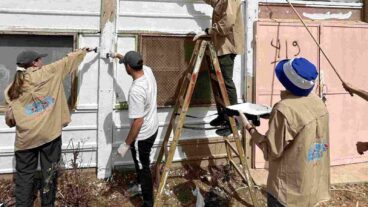Graffiti is meant to bring social or political messages to the table. And Israeli street artist, Dede, has done just that with his enormous wind-up chattering teeth canvas on the run-down Dolphinarium landmark on the Tel Aviv beachfront.
“I see this piece at the Dolphinarium as one of my most important art acts,” the Tel Aviv-based conceptual artist tells ISRAEL21c.
Dede said in a Facebook post that he “had this vision for almost a year now” to paint this 30m wide x 10m high piece.
The chattering teeth image has put the Dolphinarium venue back on the conversation table. Set on prime real estate, this building was opened in the 1980s as a venue for dolphin and sea lion shows. But it struggled to maintain its audience and closed in 1985. A discotheque and movie complex moved in to the space but a deadly suicide attack in 2001 at the dance club, in which 21 people were murdered, closed the site for good in 2002.
And while visitors over the years have often wondered why this prime real estate on the Mediterranean coast featured an ugly, derelict concrete eyesore, residents and municipal authorities alike didn’t touch it.
Until now.
Local reports announced recently that the complex is scheduled to be leveled, making way for a new section of boardwalk. Other rumors over the years have raised ideas that a new apartment complex would be built in its place.
“The bombing in the club did cross my mind a few times and was part of the message. But the main issues that lead me to the creation were: real estate, municipality, territory, ownership problems, etc,” Dede, who is currently working on a project abroad, tells ISRAEL21c in an email.
“The concept is to make people notice this piece of abandoned real estate and the issues around it; to gain awareness within the public. This place is very central and located on the beach on a very expensive spot. Yet, people don’t notice it or the problems around it.”
The bright red gums with bright white teeth creepily smiling off the Tel Aviv beachfront has now made it impossible not to notice this building.
Feedback to Dede’s canvas has been mixed. Some love it, and have added their compliments to his Facebook wall. Others have objected to his use of a terror bombing site as his canvas.
Since 2006, when he started to use his art to “communicate within the public arena,” Dede says on his website that his “creations aim to promote reexamination of personal and societal conventions . . . [presenting] the viewer with a dilemma and/or its solution in an ironic and complex way.”
Dede says he draws inspiration for his works – which can be seen in urban landscapes the world over as well as on smartphone cases — from the environment, architecture, art, rhythm, sound, politics, and passersby.
The Dolphinarium — with its history and future – truly became a perfect canvas for Israel’s street artists. Dede’s painting joins dozens of other smaller graffiti scrawls and pictures on the grey walls of the run-down building. But it was this latest work that really got the public talking again.
“A place with such history that can well serve the public is standing empty for years and has turned into visual pollution. And that is just the social concept,” says Dede. “There is the visual concept, too. Its architecture is just asking for this kind of painting.”



















